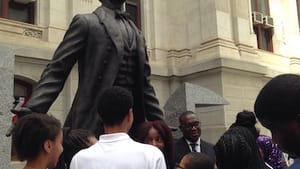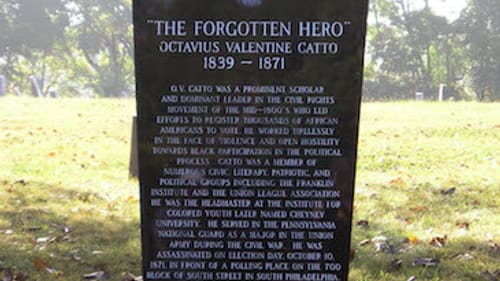Stay in the Loop
BSR publishes on a weekly schedule, with an email newsletter every Wednesday and Thursday morning. There’s no paywall, and subscribing is always free.
A monumental Philadelphian recognized at long last
Philadelphia City Hall's new Octavius Catto monument

I hadn't heard of Octavius Catto until I met him in Old City during the 2014 Fringe Festival, and he politely filled me in on a little of what my U.S. education denied me. A few years later, after the unveiling of a new monument to Catto on the south side of City Hall, I have high hopes others won’t have to wait for a chance theatrical encounter to learn about this giant of U.S. civil rights.
An important American life
Octavius Valentine Catto (or “O.V. Catto,” as the speakers at Tuesday’s unveiling called him), was a Charleston, South Carolina, native — a black man born free in 1839 whose family settled in Philadelphia when he was a child. His academics shone at Philly’s segregated institutions of learning: Vaux Primary School, Lombard Grammar School, and then, starting in 1854 until he graduated as valedictorian in 1858, at the Institute for Colored Youth — which became Cheyney University.
He went on to teach at Cheyney, and over the next decade, he teamed with Frederick Douglass to recruit black men for the Union Army and fight for the abolitionist cause. He was a major in the Pennsylvania National Guard during the Civil War and helped recruit some of the first African Americans to serve officially in the U.S. Army.
Catto was a member of countless civic, literary, and political groups and still found time to become an icon of the Negro baseball league. With Douglass and others from across the country, he co-founded the National Equal Rights League in Syracuse. At home, he campaigned for desegregated trolley cars decades before what we call the Civil Rights Era and was a critical voice in Pennsylvania’s ratification of the 15th Amendment, which gave black men the right to vote.
He was 32 in October 1871, the first Election Day on which he could vote. When he stepped out of his house on South Street, he was shot to death on his own doorstep by roving rioters who wanted to scare African Americans away from the polls.
Kenney’s mission
A monument for Catto in Philadelphia — which until this week lacked any monument to an African-American individual on public land — was a 15-year mission for Mayor Jim Kenney, who in his keynote address at the unveiling called Catto “a legendary American hero” who should be venerated in every American history class, not just during Black History Month, “the shortest month of the year.”
The mayor, who began his quest for a Catto memorial back in his days as a city councilman, said that he hopes future Philadelphia students will know as much about Catto as they do about George Washington, Benjamin Franklin, and Martin Luther King Jr. With a large crowd of students at Tuesday’s unveiling ceremony, this change is already under way.
This knowledge is especially important, the mayor added, with “a mean-spirited intolerance and ugliness emanating from our nation’s capital.”

A rest from protest
“It is hard for me to fight back tears of joy,” said O. V. Catto Memorial Fund president James Straw of the day’s festivities, which included representatives of the Octavius V. Catto Society, American Legion Post 405, the Union League, the Military Order Loyal Legion of the United States, and the Pennsylvania National Guard as well as Catto’s own great-great nephew.
O. V. Catto Memorial Fund vice president V. Chapman Smith said monuments aren’t “passive or accidental.” City Hall’s newest statue helps us give a broader lens to view individual accomplishments and events in history, understanding the fabric of justice and struggle that connects to the present day. She emphasized that Catto, who began his life as an activist at age 16, was instrumental in the ratification of the 13th, 14th, and 15th Amendments to the U.S. Constitution — a fact few people know today. What else would he have accomplished if he hadn’t been gunned down?
Proud members of the Third Regiment U.S. Colored Troops, resplendent in purple and gold, provided three booming salvos before tugging the black drapes off the new monument to ecstatic applause and cheers from the large crowd.
It felt good to be at City Hall for something other than a protest.
Catto’s question
The monument itself, by sculptor Branly Cadet, contains several pieces arranged in a grand semicircle. Catto is flanked from behind by a series of upright blocks that O. V. Catto Memorial Fund chair Carol Lawrence called a “granite abstraction of an 1860s trolley car,” hearkening back to Catto’s mission for integration of public transit. Inscribed with a few words each from Catto’s own writing, the pillars stand for Catto’s roles as educator, leader, major, and athlete.
There’s a voting box directly in front of the 12-foot-tall bronze Catto, who faces south, toward the home where racist rioters cut his life short. His heavy, distinguished clothing and determined, uplifted expression are sensitively rendered. He is in dynamic mid-stride on the plinth, as if making a lofty departure, or maybe just stepping forward. His hands are spread, palms forward, in a gesture that conveys both humility and inclusive confidence — and perhaps a solemn inquisitiveness.
He could be asking us all what comes next.
Sign up for our newsletter
All of the week's new articles, all in one place. Sign up for the free weekly BSR newsletters, and don't miss a conversation.

 Alaina Johns
Alaina Johns